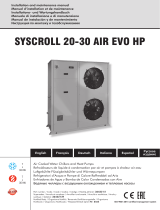D-EIMHP01501-22_00EN 2/20
INDEX
1. INTRODUCTION ..................................................................................................................................................... 4
1.1 Options and features .......................................................................................................................................... 5
2. OPERATION RANGE ............................................................................................................................................ 6
3. MAIN COMPONENTS ............................................................................................................................................ 7
4. SELECTION OF LOCATION ................................................................................................................................ 7
5. INSPECTING AND HANDLING THE UNIT ........................................................................................................ 7
6. UNPACKING AND PLACING THE UNIT ........................................................................................................... 7
7. IMPORTANT INFORMATION REGARDING THE REFRIGERANT USED .................................................. 7
8. CHECKING THE WATER CIRCUIT .................................................................................................................... 8
9. CONNECTING THE WATER CIRCUIT ............................................................................................................. 10
10. WATER CHARGE, FLOW AND QUALITY .................................................................................................. 10
11. PIPING INSULATION ...................................................................................................................................... 10
11.1 Antifreeze protection for BPHE and recovery exchangers .................................................................. 10
12. FIELD WIRING .................................................................................................................................................. 11
12.1 Power circuit and cable requirements ....................................................................................................... 11
12.2Connection of the water-cooled water chiller power supply ................................................................ 11
12.3 Point for attention regarding quality of the public electric power supply ....................................... 11
12.4 Interconnection cables .................................................................................................................................. 11
13. OPERATOR’S REPONSIBILITIES ............................................................................................................... 12
14. MAINTENANCE ................................................................................................................................................ 13
14.1 Routine maintenance ..................................................................................................................................... 13
15. SERVICE AND LIMITED WARRANTY ......................................................................................................... 16
16. BEFORE STARTING ....................................................................................................................................... 18
LIST OF TABLES
Table 1- Technical specifications (1) ............................................................................................................. 4
Table 2- Electrical specifications (1) .............................................................................................................. 4
Table 3-Water quality specifications ............................................................................................................. 9
Table 4- Water flow operation range ............................................................................................................ 10
Table 5- Impedance Z .................................................................................................................................... 11
Table 6-R410A Pressure / temperature table .............................................................................................. 13
Table 7-Standard Routine Maintenance Plan ................................................................................................ 14
Table 8 – Routine Maintenance Plan for Critical Application and/or Highly Aggressive Environment 15
Table 9- Standards steps to go through before starting the unit ............................................................. 18
LIST OF FIGURES
Figure 1- Operating limits on EWWQ014-033 ............................................................................................... 6
Figure 2- Operating limits EWWQ049-064 ..................................................................................................... 6
Figure 3- Refrigerant circuit scheme EWWQ 014 - 033 KCW1N ............................................................... 17
Figure 4- Refrigerant circuit scheme EWWQ 049 - 064 KCW1N ............................................................... 17




















